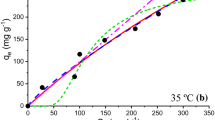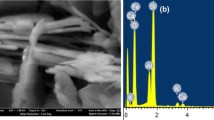Abstract
Sorption and desorption kinetics of chlorophenols, 2-chlorophenol (2-ChP), 2,4-dichlorophenol (2,4-DChP) and 2,4,5-trichlorophenol (2,4,5-TChP), in montmorillonite modified with hexadecyltrimethyl ammonium cations (HDTMA-mont) were investigated by using laboratory batch adsorbers. To investigate the effect of chemical concentration and sorbent weight on the sorption or desorption rate constants, the initial chemical concentration and sorbent weight were varied from 50 to 150 mg/L and from 0.2 to 1.0 g, respectively. A one-site mass transfer model (OSMTM) and two compartment first-order kinetic model (TCFOKM) were used to analyze kinetics. The OSMTM applicable to desorption rate analysis was newly derived. As expected from the number of model parameters involved, the three-parameter TCFOKM was better than the two-parameter OSMTM in describing sorption and desorption kinetics of chlorophenols in HDTMA-mont. The mass transfer coefficient for sorption (ks) in OSMTM generally increased as K ow value increases, except for 2,4,5-TChP, while the mass transfer coefficient for desorption (k d ) consistently increases as K ow value decreases, due to the weaker hydrophobic interaction between the solute and the organoclay. Since most sorption and desorption complete in an hour and half an hour, respectively, k d values were found to be greater than k s values for all three solutes studied. The fraction of the fast sorption (or desorption) and the first-order sorption (or desorption) rate constants for the fast and slow compartments in TCFOKM were determined by fitting experimental data to the TCFOKM. The results of kinetics reveal that the fraction of the fast sorption or desorption and the sorption rate constants in the fast and slow compartments were in the order 2,4,5-TChP>2,4-DChP>2-ChP, which agrees with the magnitude of the octanol-water partition coefficient, K ow . The first-order sorption rate constants in the fast and slow compartments were found to vary 101–102 hr−1 and 10−3–10−2 hr−1, respectively. However, the desorption rate constants in the fast and slow compartments were not correlated well withK ow . The first-order desorption rate constants in the fast compartment (101−102 hr−1) were found to be much larger than those in the slow compartment (10−3–10−4 hr−1). Sorption affinity and desorption resistance of each chlorophenol in 50% HDTMA-mont were found to show the same tendency: the weakly-sorbed chlorophenol (i.e., 2-ChP) was easily desorbed, while the strongly-sorbed chlorophenol (i.e., 2,4,5-TChP) was rather resistant to desorption.
Similar content being viewed by others
References
Boyd, S. A., Lee, J. F. and Martland, M. M., “Attenuating Organic Contaminant Mobility by Soil Modification”,Nature,333, 345 (1988).
Boyd, S. A., Mortland, M M. and Chiou, C. T., “Sorption Characteristics of Organic Compounds on Hexadecyltrimethylammonium-smectite”,Soil Sci. Soc. Am. J.,52, 652 (1988).
Boyd, S. A.,Method of Removing Hydrocarbon Contaminants from Air and Water with Organophilic, Quaternary Ammonium Ion-exchanged Smectite Clay, U.S. Patent 5,268,109 (1993).
Brusseau, M. L. and Rao, P. S. C., “Influence of Sorbate Structure on Nonequilibrium Sorption of Organic Compounds”,Environ. Sci. Technol.,25, 1501 (1991).
Burris, D. R. and Antworth, C. P., “In-situ Modification of Aquifer Material by a Cationic Surfactant to Enhance Retardation of Organic Contaminants”,J. Contam. Hydrol.,10, 325 (1992).
Carrizosa, M. J., Koskinen, W. C., Hermosin, M. C. and Cornejo, J., “Dicamba Adsorption-desorption on Organoclays”,Appl. Clay Sci.,18, 223 (2001).
Cornelissen, G., van Noort, P. C. M. and Govers, H. A. J., “Desorption Kinetics of Chlorobenzene, PAH’s and PCB’s-Sediment Extraction with Tenax® and Effects of Contact Time and Solute Hydrophobicity”,Environ. Toxicol. Chem.,16, 1351 (1997).
Crocker, F. H., Guerin, W. F. and Boyd, S. A., “Bioavailability of Naphthalene Sorbed to Cationic Surfactant-modified Smectite Clay”,Environ. Sci. Technol.,29, 2953 (1995).
Deitsch, J. J., Smith, J. A., Arnold, M. B. and Bolus, J., “Sorption and Desorption Rates of Carbon Tetrachloride and 1,2-Dichlorobenzene to Three Organobentonites and a Natural Peat Soil”,Environ. Sci. Technol.,32, 3169 (1998).
Dentel, S. K., Bottero, J. Y., Khatib, K., Demougeot, H., Duguet, J. P. and Anselme, C., “Sorption of Tannic Acid, Phenol, and 2,4,5-Trichlorophenol on Organoclays”,Wat. Res.,29, 1273 (1995).
Gullick, R W. and Weber, Jr., W. J., “Evaluation of Shale and Organoclays as Sorbent Additives for Low-permeability Soil Containment Barriers”,Environ. Sci. Technol.,35, 1523 (2001).
Huh, J. K., Song, D. I. and Jeon, Y. W., “Sorption of Phenol and Alkylphenols from Aqueous Solution onto Organically Modified Montmorillonite and Applications of Dual-mode Sorption Model”,Sep. Sci. Technol.,35, 243 (2000).
Kim, Y. S., Song, D. I., Jeon, Y. W. and Choi, S. J., “Adsorption of Organic Phenols onto Hexadecyltrimethylammonium-treated Montmorillonite”,Sep. Sci. Technol.,31, 2815 (1996).
Lee, J. F., Crum, J. and Boyd, S. A., “Enhanced Retention of Organic Contaminants by Soil Exchanged with Organic Cations”,Environ. Sci. Technol.,23, 1365 (1989).
Li, J., Smith, J. A. and Winquist, A. S., “Permeability of Earthen Liners Containing Organobentonite to Water and Two Organic Liquids”,Environ. Sci. Technol.,30, 3089 (1996).
Lo, I. M. C., “Solidification/Stabilization of Phenolic Waste using Organic-clay Complex”,J. Env. Eng.,122, 850 (1996).
Lo, I. M. C. and Lijestrand, H. M., “Laboratory Sorption and Hydraulic Conductivity Tests: Evaluation of Modified-clay Materials”,Waste Manage. Res.,14, 297 (1996).
Lo, I. M. C., “Modified Clays for Waste Containment and Pollution Attenuation”,J. Env. Eng.,123, 25 (1997).
Lo, I. M. C. and Yang, X., “Laboratory Investigation of the Migration of Hydrocarbons in Organobentonite”,Environ. Sci. Technol.,35, 620 (2001a).
Lo, I. M. C. and Yang, X. Y., “Use of Organoclay as Secondary Containment for Gasoline Storage Tanks”,J. Env. Eng.,127, 154 (2001b).
Lo, I. M. C., “Organoclay with Soil-bentonite Admixture as Waste Containment Barriers”,J. Env. Eng.,127, 756 (2001).
Nye, J. V., Guerin, W F. and Boyd, S. A., “Heterotrophic Activity of Microorganisms in Soils Treated with Quaternary Ammonium-Compounds”,Environ. Sci. Technol.,28, 944 (1994).
Nzengung, V. A., Nkedi-Kizza, P., Jessup, R. E. and Voudrias, E. A., “Organic Cosolvent Effects on Sorption Kinetics of Hydrophobic Organic Chemicals by Organoclays”,Environ. Sci. Technol.,31, 1470 (1997).
Opdyke, D. R. and Loehr, R.C., “Determination of Chemical Release Rates from Soil: Experimental Design”,Environ. Sci. Technol.,33, 1193 (1999).
Scherer, M. M., Richter, S., Valentine, R. L. and Alvarez, P. J. J., “Chemistry and Microbiology of Permeable Reactive Barriers forIn situ Groundwater Clean Up”,Crit. Rev. Environ. Sci. Technol.,30, 363 (2000).
Schrap, S. M., Sleijpen, G L. G., Seinen, W. and Opperhuizen, A., “Sorption Kinetics of Chlorinated Hydrophobic Organic Chemicals. Part II: Desorption Experiments”,Environ. Sci. Poll. Res.,1, 81 (1994).
Smith, J. A. and Jaffe, P. R., “Benzene Transport through Landfill Liners Containing Organophilic Bentonite;J. Env. Eng.,120, 1559 (1994).
Srinivasan, K. R. and Fogler, H. S., “Use of Inorgano-organo-clays in Industrial Wastewater Treatment: Structural Aspects”,Clays Clay Miner.,38, 277 (1990).
Verschueren, K.,Handbook of Environmental Data on Organic Chemicals, van Nostrand Reinhold Co., New York (1977).
Wu, Z., Cong, Y., Zhou, M., Ye, Q. and Tan, T., “Removal of Phenolic Compounds by Electro-assisted Advanced Process for Wastewater Purification”,Korean J. Chem. Eng.,19, 866 (2002).
Zhang, P. C. and Sparks, D. L., “Kinetics of Phenol and Aniline Adsorption and Desorption on an Organoclay”,Soil Sci. Soc. Am. J.,57, 340 (1993).
Zhu, L., Li, Y. and Zhang, J., “Sorption of Organobentonites to Some Organic Pollutants in Water”,Environ. Sci. Technol.,31, 1407 (1997).
Author information
Authors and Affiliations
Corresponding author
Rights and permissions
About this article
Cite this article
Kim, JH., Shin, W.S., Kim, YH. et al. Sorption and desorption kinetics of chlorophenols in hexadecyltrimethyl ammonium-montmorillonites and their model analysis. Korean J. Chem. Eng. 22, 857–864 (2005). https://doi.org/10.1007/BF02705665
Received:
Accepted:
Issue Date:
DOI: https://doi.org/10.1007/BF02705665




